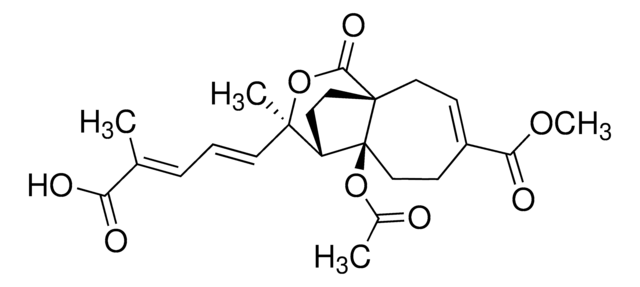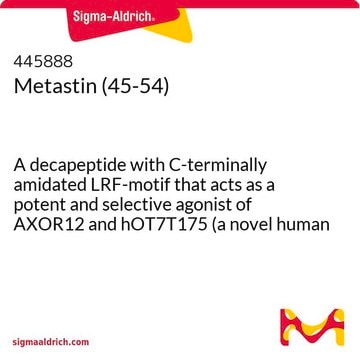L8170
Pseudolarynxsäure B
≥98% (HPLC)
Synonym(e):
O-Acetylpseudolarinsäure C
About This Item
Empfohlene Produkte
Biologische Quelle
Larix kaempferi
Assay
≥98% (HPLC)
Form
powder or crystals
Lagerbedingungen
protect from light
Farbe
white to off-white
Löslichkeit
methanol: 1 mg/mL, clear, colorless
Anwendung(en)
metabolomics
vitamins, nutraceuticals, and natural products
Lagertemp.
2-8°C
SMILES String
O=C(OC)C1=CC[C@@]2(C(O[C@@](/C=C/C=C(C(O)=O)\C)(C)[C@@H]3CC2)=O)[C@]3(OC(C)=O)CC1
InChI
1S/C23H28O8/c1-14(17(24)25)6-5-10-21(2)16-9-12-22(19(27)31-21)11-7-15(18(26)29-3)8-13-23(16,22)20(28)30-4/h5-7,10,16H,8-9,11-13H2,1-4H3,(H,24,25)/b10-5+,14-6+/t16-,21+,22+,23+/m0/s1
InChIKey
XRLYZNSOXNPKOR-CBDALDGHSA-N
Suchen Sie nach ähnlichen Produkten? Aufrufen Leitfaden zum Produktvergleich
Biochem./physiol. Wirkung
Signalwort
Danger
H-Sätze
P-Sätze
Gefahreneinstufungen
Acute Tox. 3 Oral - Repr. 2
Lagerklassenschlüssel
6.1C - Combustible acute toxic Cat.3 / toxic compounds or compounds which causing chronic effects
WGK
WGK 3
Flammpunkt (°F)
Not applicable
Flammpunkt (°C)
Not applicable
Analysenzertifikate (COA)
Suchen Sie nach Analysenzertifikate (COA), indem Sie die Lot-/Chargennummer des Produkts eingeben. Lot- und Chargennummern sind auf dem Produktetikett hinter den Wörtern ‘Lot’ oder ‘Batch’ (Lot oder Charge) zu finden.
Besitzen Sie dieses Produkt bereits?
In der Dokumentenbibliothek finden Sie die Dokumentation zu den Produkten, die Sie kürzlich erworben haben.
Unser Team von Wissenschaftlern verfügt über Erfahrung in allen Forschungsbereichen einschließlich Life Science, Materialwissenschaften, chemischer Synthese, Chromatographie, Analytik und vielen mehr..
Setzen Sie sich mit dem technischen Dienst in Verbindung.










